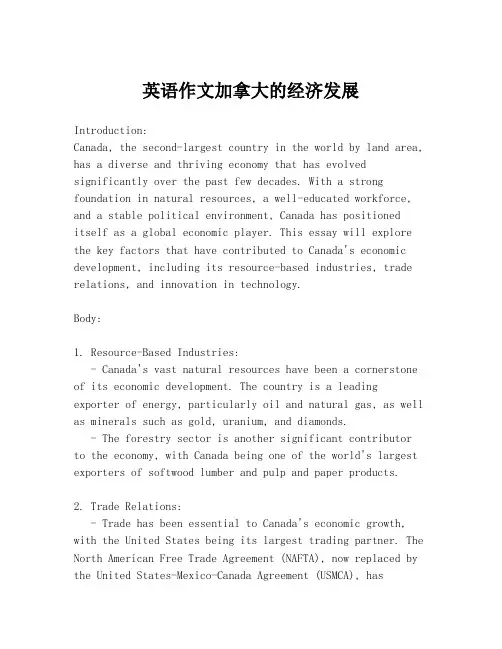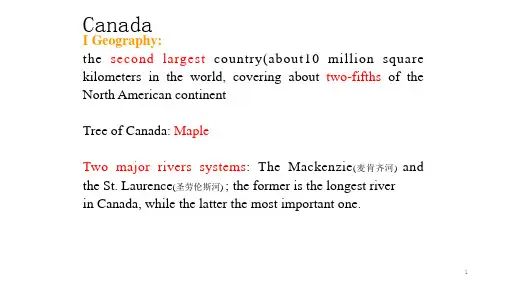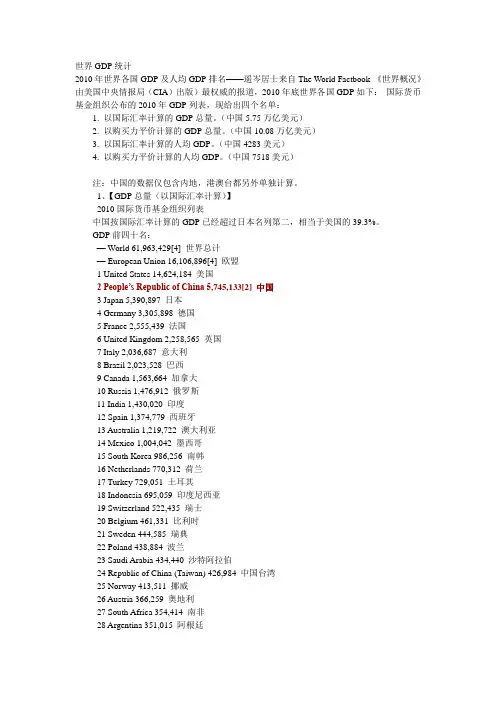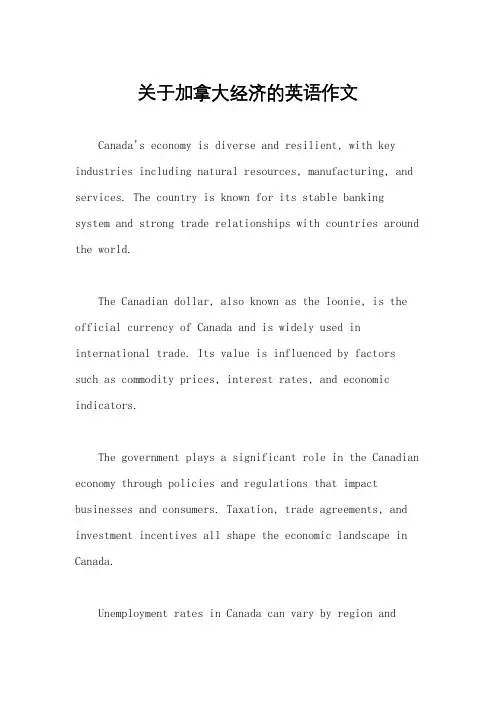加拿大GDP数据,写文章做PPT必备!非常难得找到!
- 格式:docx
- 大小:78.53 KB
- 文档页数:7

英语作文加拿大的经济发展Introduction:Canada, the second-largest country in the world by land area, has a diverse and thriving economy that has evolved significantly over the past few decades. With a strong foundation in natural resources, a well-educated workforce, and a stable political environment, Canada has positioned itself as a global economic player. This essay will explore the key factors that have contributed to Canada's economic development, including its resource-based industries, trade relations, and innovation in technology.Body:1. Resource-Based Industries:- Canada's vast natural resources have been a cornerstone of its economic development. The country is a leading exporter of energy, particularly oil and natural gas, as well as minerals such as gold, uranium, and diamonds.- The forestry sector is another significant contributor to the economy, with Canada being one of the world's largest exporters of softwood lumber and pulp and paper products.2. Trade Relations:- Trade has been essential to Canada's economic growth, with the United States being its largest trading partner. The North American Free Trade Agreement (NAFTA), now replaced by the United States-Mexico-Canada Agreement (USMCA), hasfacilitated trade and economic integration with its neighbors. - Canada's trade policy also extends globally, with the country seeking to diversify its markets and reduce relianceon the US through agreements with the European Union andAsia-Pacific countries.3. Innovation and Technology:- Canada has made significant investments in research and development, particularly in the fields of information technology, aerospace, and life sciences. This has led to the growth of a knowledge-based economy and the creation of high-value jobs.- The country's commitment to innovation is evident in its support for start-ups and its focus on sectors such asartificial intelligence, clean technology, and biotechnology.4. Banking and Financial Services:- Canada's financial sector is robust and well-regulated, providing stability and growth to the economy. The country's banks are consistently ranked among the world's strongest, contributing to its reputation as a safe haven for investment.5. Challenges and Future Prospects:- While Canada's economy has shown resilience, it faces challenges such as the need to transition from a resource-dependent economy to a more diversified and sustainable model. - Climate change and the global shift towards renewable energy sources also present both risks and opportunities for Canada's economic development.Conclusion:Canada's economic development has been shaped by its abundant natural resources, strategic trade relations, and commitment to innovation. As the country continues to evolve and address contemporary challenges, it remains an important player on the global economic stage. The future of Canada's economywill likely depend on its ability to diversify, adapt to changing global dynamics, and maintain its competitive edgein a rapidly changing world.。


世界GDP统计2010年世界各国GDP及人均GDP排名——遥岑居士来自The World Factbook 《世界概况》由美国中央情报局(CIA)出版)最权威的报道,2010年底世界各国GDP如下:国际货币基金组织公布的2010年GDP列表,现给出四个名单:1. 以国际汇率计算的GDP总量。
(中国5.75万亿美元)2. 以购买力平价计算的GDP总量。
(中国10.08万亿美元)3. 以国际汇率计算的人均GDP。
(中国4283美元)4. 以购买力平价计算的人均GDP。
(中国7518美元)注:中国的数据仅包含内地,港澳台都另外单独计算。
1、【GDP总量(以国际汇率计算)】2010国际货币基金组织列表中国按国际汇率计算的GDP已经超过日本名列第二,相当于美国的39.3%。
GDP前四十名:— World 61,963,429[4] 世界总计— European Union 16,106,896[4] 欧盟1 United States 14,624,184 美国2 People’s Republic of China 5,745,133[2] 中国3 Japan 5,390,897 日本4 Germany 3,305,898 德国5 France 2,555,439 法国6 United Kingdom 2,258,565 英国7 Italy 2,036,687 意大利8 Brazil 2,023,528 巴西9 Canada 1,563,664 加拿大10 Russia 1,476,912 俄罗斯11 India 1,430,020 印度12 Spain 1,374,779 西班牙13 Australia 1,219,722 澳大利亚14 Mexico 1,004,042 墨西哥15 South Korea 986,256 南韩16 Netherlands 770,312 荷兰17 Turkey 729,051 土耳其18 Indonesia 695,059 印度尼西亚19 Switzerland 522,435 瑞士20 Belgium 461,331 比利时21 Sweden 444,585 瑞典22 Poland 438,884 波兰23 Saudi Arabia 434,440 沙特阿拉伯24 Republic of China (Taiwan) 426,984 中国台湾25 Norway 413,511 挪威26 Austria 366,259 奥地利27 South Africa 354,414 南非28 Argentina 351,015 阿根廷29 Iran 337,901 伊朗30 Thailand 312,605 泰国31 Greece 305,00532 Denmark 304,55533 Venezuela 285,21434 Colombia 283,10935 United Arab Emirates 239,65036 Finland 231,982— Hong Kong 226,48537 Portugal 223,70038 Malaysia 218,95039 Singapore 217,37740 Egypt 216,8302、【GDP总量(以购买力平价计算)】2010国际货币基金组织列表中国按购买力平价计算的GDP已经达到美国的69.0%。


关于加拿大经济的英语作文Canada's economy is diverse and resilient, with key industries including natural resources, manufacturing, and services. The country is known for its stable banking system and strong trade relationships with countries around the world.The Canadian dollar, also known as the loonie, is the official currency of Canada and is widely used in international trade. Its value is influenced by factors such as commodity prices, interest rates, and economic indicators.The government plays a significant role in the Canadian economy through policies and regulations that impact businesses and consumers. Taxation, trade agreements, and investment incentives all shape the economic landscape in Canada.Unemployment rates in Canada can vary by region andindustry, with factors such as technological advancements, globalization, and economic cycles affecting job opportunities. The government provides support through programs and initiatives to help individuals find employment.Small businesses are the backbone of the Canadian economy, accounting for a significant portion of employment and economic activity. These enterprises face challenges such as access to financing, market competition, and regulatory compliance.Overall, Canada's economy continues to grow and evolve, driven by innovation, entrepreneurship, and a skilled workforce. With a focus on sustainability and inclusivity, the country is well-positioned for future success in the global marketplace.。





